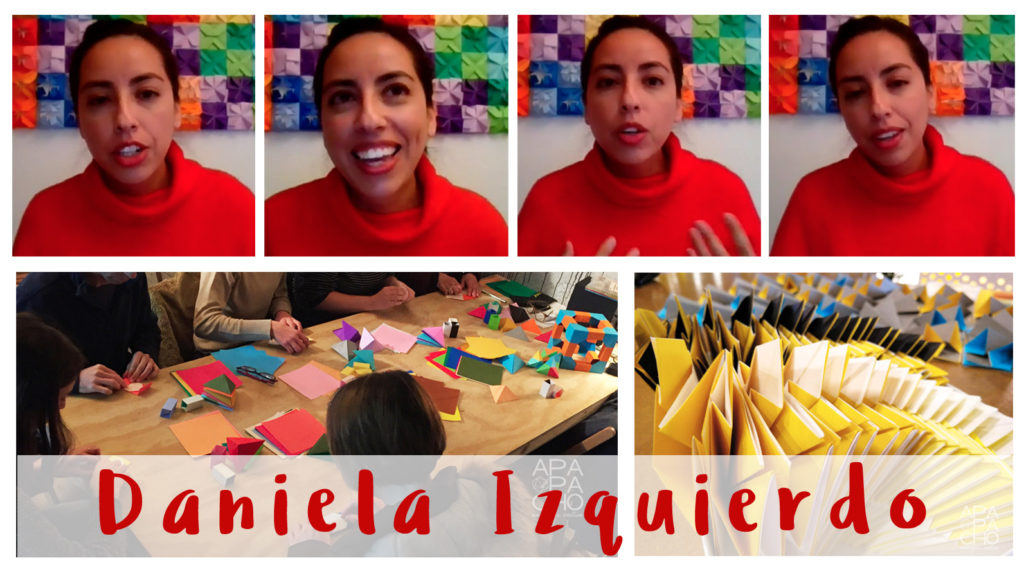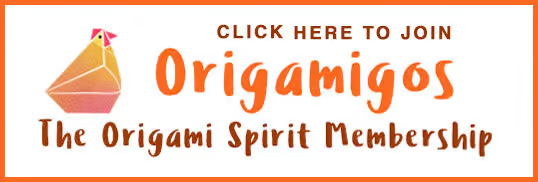
On October 27th I interviewed Daniela Izquierdo for the Origami Spirit Membership. I’d like to share some of our conversation as an example of the content being offered in ORIGAMIGOS, the Origami Spirit membership.
Originally from Mexico, Daniela currently lives in Spain. She works with an interdisciplinary team of designers and engineers who use ORIGAMI as a creative tool utilizing the health benefits of origami for stress management and to help people develop visual and manual thinking. Most of the special projects and workshops Daniela is involved with are conducted in Madrid, but there are also ongoing projects in Mexico and Britain. In our hour-long discussion we touched on many topics:
- The importance of origami as a way to strengthen family bonds.
- Adapting origami for work with Alzheimer’s patients and caregivers.
- The usefulness of origami in cognitive stimulation.
- Teaching design principles through origami to architecture students at Monterrey Institute of Technology.
- PhD research project, Durham University, UK. Topic: Origami as a stress-reducing practice.
Adapting origami for work with Alzheimer’s patients and caregivers
–An excerpt from my interview with Daniela Izquierdo.
Leyla Torres: You have worked in collaboration with the Mexican Alzheimers Association. So there is that connection between the health field and origami and you have used origami to work with these patients. Can you tell us about your work as it relates to Alzheimer’s patients?
Daniela Izquierdo: I started working with the Mexican Alzheimer’s Association seven years ago. I got involved in that area because of a design project, but it was a very specific design project for an Alzheimer’s event. After that, I realized that there were needs that needed to be met for people that had Alzheimer’s but also for their caregivers and families.
The president of the Mexican Alzheimer association said she wanted to develop tools that could help Alzheimer’s, patients their families, and other caregivers, especially in a country like Mexico where the resources for most people are very limited.
She explained that even though there are existing materials that could help with cognitive stimulation, they were expensive or only intended for children. For example, therapists, or caregivers, would use materials designed for children when they worked with Alzheimer’s patients, but these materials depressed them because they were aware of what was happening to them.
Instead of helping them maintain their cognitive abilities, the whole purpose of cognitive stimulation therapies, being asked to do children’s activities would accelerate decline due to stress and demotivation. What was needed, she stated, was materials for adults that could be adapted to different Alzheimer’s stages and could be adjusted to the progressive rate of decline unique to each person.
We started exploring options. I was a professor at the University at Monterrey at that time, so my students and I proposed various solutions. And then, I started thinking about how origami could be a really useful tool for this. I talked with my mother about it––she was my first origami teacher and mentor when I was very young––and asked her what she thought of the idea. She agreed that if origami is useful for children, it could also be useful for adults.
So we started experimenting at a facility for adults in Mexico City, testing various exercises with people who were at different Alzheimer’s stages. We also consulted with a neuropsychologist who worked in collaboration with the Alzheimers Association, and we eventually proposed some simple exercises that ranged from easy to difficult.
Origami could be an activity not only useful for cognitive stimulation, but it could also be shared, to bring people together: the person with dementia, the caregiver, and the family. If a caregiver gives a person with dementia a children’s puzzle and the caregiver is only an observer while the person with dementia is doing the activity, it’s clearly dissatisfying for both. It creates a separation that is unsatisfying and demotivating for everyone.
But we thought about what could happen if origami activities could be shared. Maybe a nice composition to display on the wall, or something that could be given to a child or grandchild, or just an accomplishment to be proud of.
I also asked people how they felt about other activities. One common cognitive stimulation activity used with Alzheimer’s patients is taking little pieces of wood, and stringing them on a cord to make a necklace. The objective is to stimulate fine motor control in the fingers, with the index finer and thumb in opposition. This movement is important to many cognitive processes and these activities help the person with dementia retain fine motor control. Once they lose this movement, they can’t do things like hold a glass or bottle.
A lot of exercises practice this movement. With origami, you do this all the time because you’re grasping paper and folding it with your thumb and forefinger. You need to take the paper and turn it over. With origami, you’re always doing such movements.
When I asked people about the necklace stringing activity they said that at the end of the session, the therapist would take the necklace apart and put the pieces away and they’d be left with nothing. So they were frustrated and thinking, what’s the point of me doing this?
Origami solves a lot of these issues. You practice. You have a really affordable material and you can even use recycled paper if you don’t have origami paper. You could even color your own paper, another great activity that emphasizes the process. And you can create simple or complicated compositions. And most important, there is a result that affirms the effort that satisfies everyone.
The exercises that we developed are different levels of difficulty, and we can explain how to make them simpler or more complex and adapt to them as needed. Putting all this information together, we created a handbook with exercises that have different levels of difficulty. It was created in collaboration with the Mexican Alzheimer’s Association and is available as a free PDF download on our web page, in Spanish or in English, for anyone who wants to use it.
………………………………………………
This interview excerpt is an example of the content being offered within the ORIGAMIGOS membership. Also included within the membership are exclusive tutorials, printables, and an engaged and supportive community.
ORIGAMIGOS welcomes paper-folders at any skill level from NOVICE to EXPERT to explore aspects of origami as a mindful, educational, artistic, entertaining, and intellectual practice.
Related Posts:
- How a Paper Heart can Help You Stay Healthy
- Origami Art Therapy for Mental Health
- Recovering Health Through Origami
- The Smile of Mona Lisa
- Dr. Lizzie Burns Uses Origami in her Anti-Boredom Campaign
- Origami – A Help to Alzheimer’s Patients
- Stay Calm and Make an Origami Ladybug
- All That’s Worth Cherishing Begins in the Heart





I would love to join you, maybe you could help me. I miss my Origami. X Jennifer (Jen) Davies.
Hi Jennifer,
We will be opening the membership soon. Make sure that you are subscribed to Origami Spirit to receive notifications.
To subscribe, click HERE
I enjoyed reading about Daneila Ezquierdo and her work with Alzheimer. Very inspirational.
Thanks for sharing her story.
Thank you Sharon. As a member of Origamigos, you have access to the full interview.